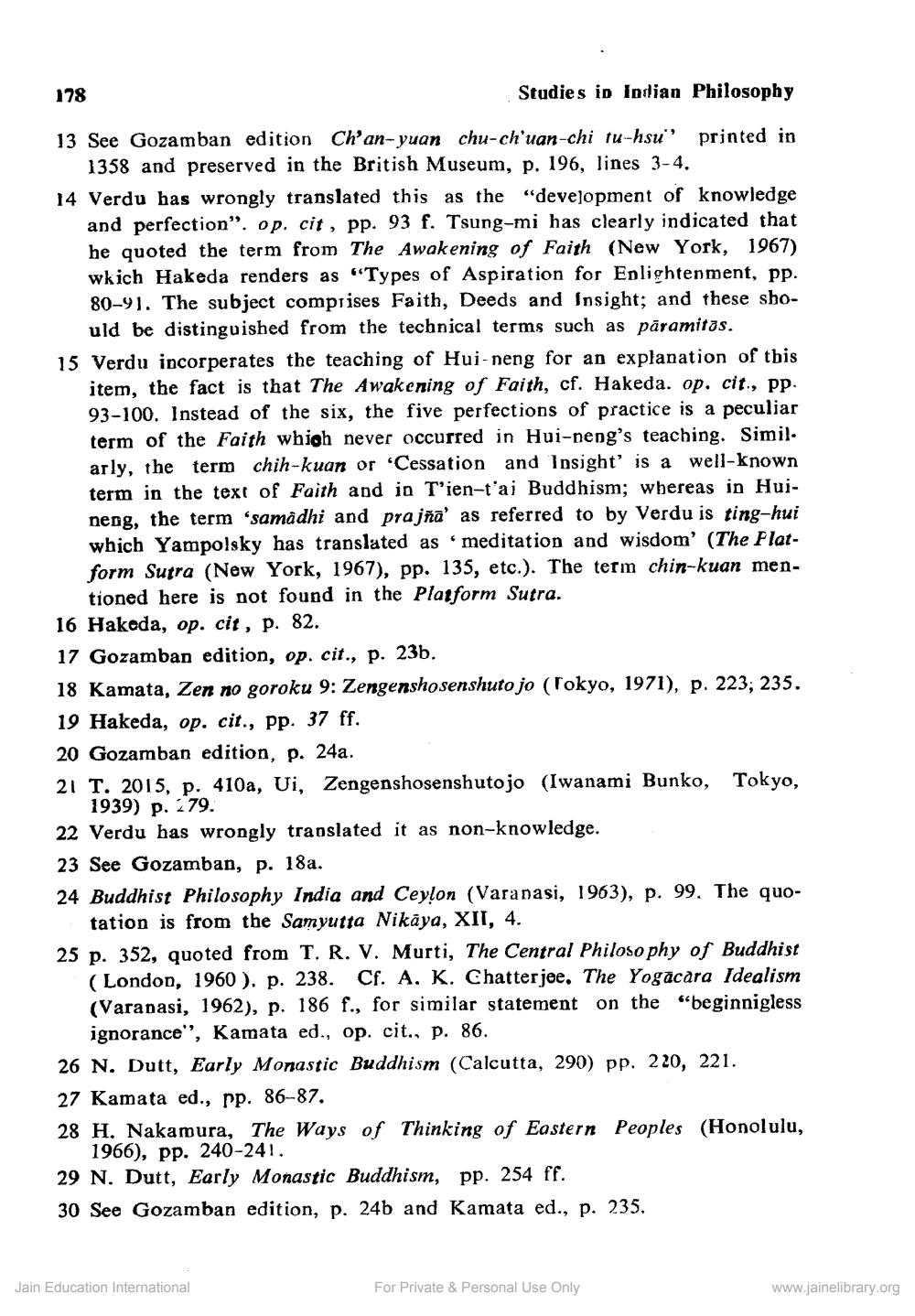________________
178
Studies in Indian Philosophy
13 See Gozamban edition Ch'an-yuan chu-ch'uan-chi tu-hsu"' printed in
1358 and preserved in the British Museum, p. 196, lines 3-4. 14 Verdu has wrongly translated this as the “development of knowledge
and perfection”. op. cit, pp. 93 f. Tsung-mi has clearly indicated that he quoted the term from The Awakening of Faith (New York, 1967) wkich Hakeda renders as "Types of Aspiration for Enlightenment, pp. 80-9). The subject comprises Faith, Deeds and Insight; and these sho
uld be distinguished from the technical terms such as pāramitas. 15 Verdu incorperates the teaching of Hui-neng for an explanation of this
item, the fact is that The Awakening of Faith, cf. Hakeda. op. cit., pp. 93-100. Instead of the six, the five perfections of practice is a peculiar term of the Faith which never occurred in Hui-neng's teaching. Simil. arly, the term chih-kuan or 'Cessation and Insight' is a well-known term in the text of Faith and in T'ien-t'ai Buddhism; whereas in Huineng, the term 'samadhi and prajña' as referred to by Verdu is ting-hui which Yampolsky has translated as meditation and wisdom' (The Flatform Sutra (New York, 1967), pp. 135, etc.). The term chin-kuan men
tioned here is not found in the Platform Sutra. 16 Hakeda, op. cit, p. 82. 17 Gozamban edition, op. cit., p. 23b. 18 Kamata, Zen no goroku 9: Zengenshosenshuto jo (Tokyo, 1971), p. 223; 235. 19 Hakeda, op. cit., pp. 37 ff. 20 Gozamban edition, p. 24a. 21 T. 2015, p. 410a, Ui, Zengenshosenshutojo (Iwanami Bunko, Tokyo,
1939) p. 279. 22 Verdu has wrongly translated it as non-knowledge. 23 See Gozamban, p. 18a. 24 Buddhist Philosophy India and Ceylon (Varanasi, 1963), p. 99. The quo
tation is from the Samyutta Nikäya, XII, 4. 25 p. 352, quoted from T. R. V. Murti, The Central Philosophy of Buddhist
(London, 1960), p. 238. Cf. A. K. Chatterjee, The Yogacara Idealism (Varanasi, 1962), p. 186 f., for similar statement on the “beginnigless
ignorance", Kamata ed., op. cit., p. 86. 26 N. Dutt, Early Monastic Buddhism (Calcutta, 290) pp. 220, 221. 27 Kamata ed., pp. 86-87. 28 H. Nakamura, The Ways of Thinking of Eastern Peoples (Honolulu,
1966), pp. 240-241. 29 N. Dutt, Early Monastic Buddhism, pp. 254 ff. 30 See Gozamban edition, p. 24b and Kamata ed., p. 235.
Jain Education International
For Private & Personal Use Only
www.jainelibrary.org




